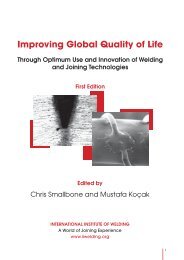(LTT) Filler Wires
(LTT) Filler Wires
(LTT) Filler Wires
Create successful ePaper yourself
Turn your PDF publications into a flip-book with our unique Google optimized e-Paper software.
mechanism will absorb the strain energy and limit crack<br />
extension. Also, austenite has higher solubility for<br />
hydrogen than martensite, and thus it will absorb<br />
hydrogen from martensite. This will, in turn, help to<br />
lower hydrogen concentration in martensite [30].<br />
Experiments on the welds produced with different <strong>LTT</strong><br />
weld consumables [31] show that cold cracking can be<br />
avoided when appropriate contents of retained austenite<br />
are existent as seen from Table 2 and Figures 8. and 9 It<br />
was demonstrated that the joint produced with <strong>LTT</strong><br />
weld consumables, i.e. 12% Ni, yielded in a<br />
microstructure containing some retained austenite due<br />
to its low M S temperature, i.e. 40 o C, and showed the<br />
highest crack resistance, Figure 8. It was reported that<br />
as the nickel content in the filler wire increases the<br />
transformation temperature and thus the crack ratio<br />
decreases. The crack ratio decreases down to about 30%<br />
at a Ni-content of 10% and crack-free welds are<br />
obtained with the use of weld consumables containing<br />
12% Ni. This can be attributed to the presence of<br />
compressive residual stresses in the joint and of retained<br />
austenite in the microstructure [31]. These results<br />
indicate that <strong>LTT</strong> filler wires may be succesfully used<br />
to avoid cold cracking.<br />
Similarly, Shiga et al. [18] reported that <strong>LTT</strong> welding<br />
consumables with a M S temperature of 100<br />
o C,<br />
resulting in a dual phase microstructure consisting of<br />
martensite and austenite, completely suppresses cold<br />
cracking without preheating, Figure 10. However, to<br />
what extent the M S temperature (thus the presence of<br />
retained austenite) and residual stresses are responsible<br />
for the suppression of cold cracking have not yet been<br />
determined [18].<br />
Table 2. Crack ratios and hardness values obtained with various<br />
<strong>LTT</strong> consumables in Tekken test<br />
<strong>LTT</strong><br />
Alloy<br />
Hardness<br />
HV10<br />
Surface<br />
crack ratio<br />
in %<br />
Section crack<br />
ratio in %<br />
8%Ni 417 70 60<br />
10%Ni 401 0 30<br />
12%Ni 394 0 0<br />
Figure 9. Variation of crack ratios and hardness values with M S<br />
temperatures obtained with various <strong>LTT</strong> consumables in Tekken<br />
test [31]<br />
(a)<br />
(b)<br />
Figure 8. Cross sections of the joints produced with <strong>LTT</strong><br />
consumables with varying Ni-contents after Tekken test:<br />
a) %10 Ni and b) %12 Ni [31]<br />
6. General remarks<br />
Recent studies have clearly demonstrated that <strong>LTT</strong><br />
welding consumables produces fully martensitic<br />
structure or martensitic structure containing some<br />
retained beta. Residual tensile stresses are lowered or<br />
compressive residual stresses are generated within the<br />
weld region due to martensitic expansion when the<br />
transformation takes place at lower temperatures. Thus,<br />
weld properties such as fatigue strength and cold<br />
cracking resistance are increased without any costly<br />
post-weld treatment.<br />
However, some issues concerning <strong>LTT</strong> consumables<br />
such as effects of multipass welding and dilution with<br />
parent plate are to be clarified throughly before it can<br />
be concluded that the use of these new consumables is<br />
a practical approach of increasing fatigue performance<br />
and minimizing welding induced deformation. It also<br />
remains to develop suitable <strong>LTT</strong> consumables, which<br />
do not only modify the stress distribution, but also<br />
provide acceptable static strength and impact<br />
toughness. Another issue to be clarified is hot cracking<br />
since the main alloying addition in these consumables<br />
for suppressing M S temperature is Ni, which maight<br />
shift the weld metal into austenitic solidification.<br />
Alternative alloying concepts should therefore be<br />
investigated for the sake of safety from the practical<br />
point of view.<br />
Nevertheless, the studies conducted up to date clearly<br />
demonstrate that the use of <strong>LTT</strong> consumables is a<br />
promising approach for reducing the risk of welded<br />
component fatigue failure without any post-weld<br />
764
















